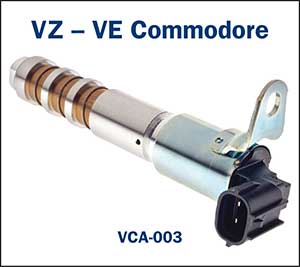Latest News
Testing Variable Camshaft Actuators (VCA)
What a Technician needs to know when carrying out an electrical test on the VCA and related circuitry when an associated fault code is logged.
Typically – P0010, P0011 and P0014 for both intake and exhaust VCA solenoids.
Note: Refer to previous VCA article for detailed component operation, hydraulic circuit operation and diagnosis of the VVT system.
When an intermittent or hard VCA fault has been logged, the technician needs to determine whether the cause of the fault is mechanical, hydraulic or electrical.
On vehicle electrical tests.
Depending on the vehicle, the number of VCA units may vary – typically 2 or 4 units. These individual Intake and Exhaust VCA units may be identical and interchangeable or may require specific Intake or Exhaust fit only units.
In the field, some of these VCA solenoid valves are electrically problematic but it is recommended to renew all units if one has been found to be electrically faulty.
Interchangeable Type VCA Unit

Specific Intake or Exhaust Fit Only VCA Units.

Once the VCA unit has been correctly identified, the technician can then carry out specific electrical tests to determine if the VCA unit is the cause of the fault.
The quickest test to carry out is the simple VCA solenoid windings resistance test. This can be carried out on the vehicle if access to the terminals is easily achieved and with the harness disconnected from the VCA units.
This reading may vary slightly due to the effect of heat on the VCA solenoid windings.
Typical VCA readings may range from approx. 6 Ohms to approx. 20 Ohms but carrying out this simple test on a VCA that has an intermittent electrical contact may bring a faulty solenoid back to life due to the force applied to the terminal pins re-contacting the internal solenoid windings. Moving the terminal pins again may recreate the faulty condition. This is generally referred to in the trade as “stressing the terminals”.
Beware: there are times in the field where re-creating the electrical vehicle fault may not be easily duplicated instantly after tampering with the connections.
Carrying out an on vehicle Functional test on the VCA solenoid using a suitable Scanner, is also a quick test that allows the technician to monitor the VCA operation by audible means. (hear the solenoid operation when activated). A solenoid that lacks the operation audible sound will require further tests on the solenoid or the electrical activation circuit.
This test is generally carried out in an Engine off condition and flexing the connector housing may create intermittent results.
Carrying out an Engine Running desired and actual CAM angle test with a suitable scanner will Instantly allow the full monitoring of the VCA effect on the cam angle.
Typical procedure with engine running:
The Desired angle of a selected intake or exhaust cam angle can be physically altered by the technician using the scanner Increase or Decrease commands.
Setting a specific targeted desired cam angle (visible on the scanner screen) and monitoring the related actual cam angle (again visible on the scanner screen) would indicate if the actuator solenoid or circuits allow the cam angle to match the desired angle.
That is: if the desired angle was increased or decreased and the actual angle remained constant, that would indicate a system fault. Further VCA solenoid valve or circuit testing would be required to verify the actual area of fault.
Typical scanner screen during engine running test:

Note: It is advisable to clean the area around the VCA valve prior to removal to prevent any debris entering the opening as the unit is removed.
The Premier Auto Trade Emission range includes more than 55 Variable Camshaft Actuators (VCA), covering almost 6.5 million vehicle applications in Australia and NZ.
When you supply and fit products from Premier Auto Trade you can expect a product designed and tested to the vehicle manufacturer’s specifications offering OE form, fit and function. Premier Auto Trade distributes products throughout Australia via a network of specialised resellers and leading automotive groups. |



